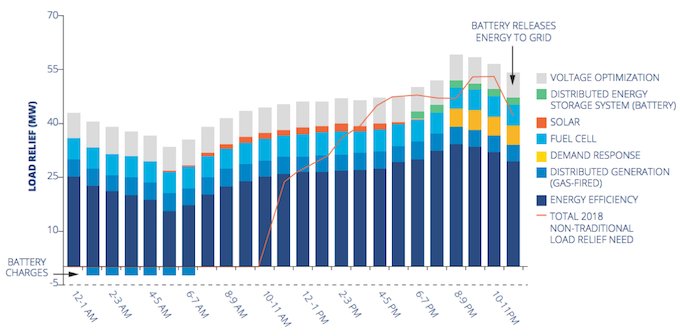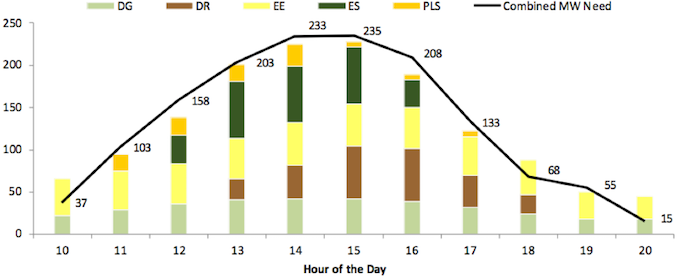The increased prevalence of distributed energy resources is driving changes to utility planning. Our new report, The Role of Energy Efficiency in a Distributed Energy Future, found that most utilities are not currently using energy efficiency in distribution system planning, but several states are pursuing new approaches to using efficiency to displace traditional distribution infrastructure upgrades and integrate more renewables into the grid. These states provide clear examples of how energy efficiency can be used as a resource on the distribution system.
Energy Efficiency as a Distributed Energy Resource
The purpose of distributed resource planning processes is to integrate distributed energy resources into the grid and address other related issues such as rate design and valuation approaches. However there is no common definition of distributed energy resources. The National Association of Regulatory Utility Commissioners defines it as “a resource sited close to customers that can provide all or some of their immediate electric and power needs and can also be used by the system to either reduce demand or provide supply to satisfy the energy, capacity, or ancillary service needs of the distribution grid.” Our review of other definitions shows that most, but not all, include energy efficiency, which allows utilities and customers to cost effectively reduce energy needs and demand.
Utilities have been implementing energy efficiency as a resource for several decades and the benefits of efficiency are also well documented (here, here, and here). At the distribution level, energy efficiency may delay or avoid the need for new distribution infrastructure, and also reduce demand and energy needs at individual homes and businesses.
Current Practices and Leading States
To understand how utilities are considering energy efficiency in distribution system planning, we administered a survey to more than 30 utilities and reviewed active regulatory proceedings in key states. Our review found that while some utilities included energy efficiency savings in demand forecasts, most utilities are not using energy efficiency as a resource in distribution system planning. California and New York are still early in developing regulatory approaches to these issues, but are at the forefront of considering energy efficiency (and other distributed energy resources) in distributed planning.
New York, through the Reforming the Energy Vision (REV) proceeding, is attempting to create a marketplace of energy products and services for retail customers to optimize the level of distributed energy resources on the grid. While New York is still very early in the process, some aspects of REV have provided valuable insights on how energy efficiency can be used to delay the need for large-scale projects on the distribution system. The Brooklyn-Queens Demand Management (BQDM) Program is a useful case study of how ConEd is utilizing energy efficiency to reduce demand in a constrained area to delay a substation upgrade. The figure below shows the results of these efforts so far. The majority of demand reductions have been achieved through the implementation of several energy efficiency programs aimed at reducing demand in nearby buildings.
In California, the Public Utilities Commission is leading an effort to formalize several aspects of distributed resource planning. The state’s three largest utilities, San Diego Gas and Electric, Pacific Gas and Electric, and Southern California Edison, are all implementing proof-of-concept projects to demonstrate the effectiveness of methods to estimate benefits of alterative resource portfolios and to validate the ability of projects to achieve these benefits. Southern California Edison’s demonstration project, known as the Preferred Resources Pilot, is using energy efficiency to reduce local demand and defer the need to upgrade a potentially constrained substation. As the figure below shows, Southern California Edison is relying on energy efficiency to meet a significant part of the demand reductions.
Other states, such as Rhode Island, Washington State, Minnesota, Oregon, and Connecticut, are also engaged in efforts to value energy efficiency as a distributed resource and improve planning processes to consider alternative resources to building new distribution system infrastructure. Their progress should be monitored for best practices and case studies of how to value and incorporate energy efficiency into enhanced system planning.
Looking Ahead
The electric utility industry is in a period of fundamental change, which presents an opportunity to improve system planning processes to better incorporate energy efficiency. Our review of current practices and ongoing proceedings shows that most states are defining distributed energy resources to include energy efficiency but that most electric utilities are not using energy efficiency in distribution system planning. However, several leading states are providing useful information on methods of estimating locational and temporal value of energy efficiency in the context of distribution system planning.
These states are also providing valuable insights through demonstration projects designed to geographically target energy efficiency to achieve demand reductions. These efforts provide guidance to other states on how to best utilize energy efficiency as a distributed energy resource. Geographically targeted efficiency provides significant benefits and is a valuable complement to system-wide efficiency.
As regulators and utilities work to modernize the distribution system and integrate distributed energy resources, energy efficiency should be a cornerstone in planning efforts. Efficiency can reduce utility system costs and enable the existing system to support more renewable energy while saving customers money.





